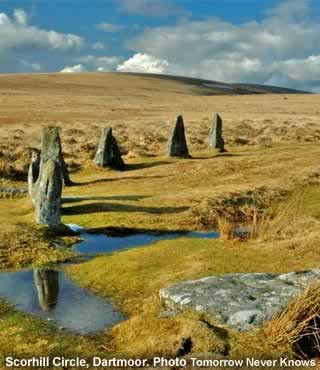Dartmoor |
|
 |
|||
Named after the River Dart and made up of nearly a thousand square kilometres of moorland |
||
Listen to this article |
||
Dartmoor National Park is made up of nearly a thousand square kilometres of moorland, in the centre of Devon county. It was one of the settlement areas for much of Britain's prehistoric population, especially during the Bronze Age. This means that today, Dartmoor is home to England's largest collection of relics and artefacts from that time period. |
||
The most noticeable of these remains are the numerous standing stones, which are often arranged in rows, or circles. Archaeologists are still at a loss to explain what these formations were used for. Nevertheless, the stones make for intriguing sights - and as there are over a hundred of them, you're likely to come across one while walking through just about any area of the park. |
||
Dartmoor is actually a walker's paradise, with its breathtaking open expanses. Much of it is classified as "access land", which means that - even though it is privately owned - there are no restrictions on where the public can walk. Even in the other areas of the park, there are hundreds of kilometres of paths and bridleways - so there's rarely anywhere you can't go. |
||
An increasingly popular activity to take part in as you walk is "letterboxing", where participants use their maps and compasses to try and track down a series of watertight boxes, which are scattered across the moor. Each one contains a logbook, into which people can write a record of their achievement. "Geocaching" is a similar, more modern version, played using GPS devices. |
||
No matter where you wander within Dartmoor, you'll never be far from one of its famous 'Tors'. This is the name for one of the park's many hills, which are often topped with rocky outcrops. These are made of granite, a stone which runs through the entire area. The tors provide many opportunities for bouldering and rock climbing, at both beginner and expert levels. They are also the setting for the annual "Ten Tors" challenge, where several hundred teams try to scale ten of the hills within two days. |
||
Dartmoor is named after the River Dart, which actually begins as two rivers - they flow from the east and west sides of the park respectively, before joining up at Dartmeet, a particularly beautiful spot which features the remains of an ancient bridge, formed from slabs of granite. Elsewhere on the river, you can hop inside a kayak and paddle your way along the water - or hire out a fishing boat and test out your angling skills. |
||
Throughout Dartmoor National Park there are many small towns and villages, filled with pretty buildings, traditional pubs, and local markets. Highlights include Ashburton - the largest town within the park boundaries - and Buckfastleigh, which is home to an active Benedictine abbey. |
||
The moors are also the setting for Sir Arthur Conan Doyle's "Hound of the Baskervilles", often considered as Sherlock Holmes' greatest case! The tale told of a huge spectral hound, which stalked the land, terrifying people with its fiery eyes, and sharp teeth. So as you walk through Dartmoor, no-one will blame you if you keep one eye over your shoulder! |
||
|
||
Dartmoor High Moorland Visitor Centre, Duchy Building, Tavistock Road, Princetown, PL20 6QF. Tel: 01822 890414 |
||
|
Pocket Britain is optimised for use on a smartphone or tablet with internet access. All content is subject to copyright. All reasonable methods have been used to ensure information supplied is accurate at the time of publication. However, it is advisable to check information before relying on it. Privacy Policy |